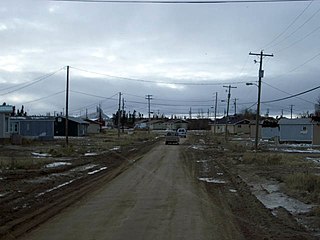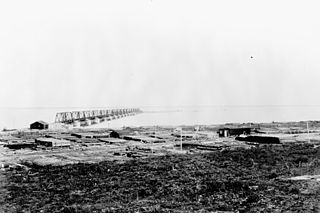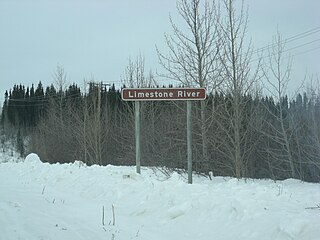
The Cree are a North American Indigenous people. They live primarily in Canada, where they form one of the country's largest First Nations.

The Nelson River is a river of north-central North America, in the Canadian province of Manitoba. The river drains Lake Winnipeg and runs 644 kilometres (400 mi) before it ends in Hudson Bay. Its full length is 2,575 kilometres (1,600 mi), it has mean discharge of 2,370 cubic metres per second (84,000 cu ft/s), and has a drainage basin of 1,072,300 square kilometres (414,000 sq mi), of which 180,000 square kilometres (69,000 sq mi) is in the United States.

Fort Severn First Nation is a Western Swampy Cree First Nation band government located on the Severn River near Hudson Bay. It is the most northern community in Ontario, Canada. In 2001, the population was 401, consisting of 90 families in an area of 40 square kilometres. The legal name of the reserve is Fort Severn 89, with the main settlement of Fort Severn.

The Nelson River DC Transmission System, also known as the Manitoba Bipole, is an electric power transmission system of three high voltage, direct current lines in Manitoba, Canada, operated by Manitoba Hydro as part of the Nelson River Hydroelectric Project. It is now recorded on the list of IEEE Milestones in electrical engineering. Several records have been broken by successive phases of the project, including the largest mercury-arc valves, the highest DC transmission voltage and the first use of water-cooled thyristor valves in HVDC.

The Nisichawayasihk Cree Nation is a Cree First Nations community centered in Nelson House, Manitoba, Canada. Its main reserve is Nelson House 170.

The Manitoba Hydro-Electric Board, operating as Manitoba Hydro, is the electric power and natural gas utility in the province of Manitoba, Canada. Founded in 1961, it is a provincial Crown Corporation, governed by the Manitoba Hydro-Electric Board and the Manitoba Hydro Act. Today the company operates 16 interconnected generating stations. It has more than 527,000 electric power customers and more than 263,000 natural gas customers. Since most of the electrical energy is provided by hydroelectric power, the utility has low electricity rates. Stations in Northern Manitoba are connected by a HVDC system, the Nelson River Bipole, to customers in the south. The internal staff are members of the Canadian Union of Public Employees Local 998 while the outside workers are members of the International Brotherhood of Electrical Workers Local 2034.

Northern Manitoba is a geographic and cultural region of the Canadian province of Manitoba. Originally encompassing a small square around the Red River Colony, the province was extended north to the 60th parallel in 1912. The region's specific boundaries vary, as "northern" communities are considered to share certain social and geographic characteristics, regardless of latitude.

Gillam is a town on the Nelson River in northern Manitoba, Canada. It is situated between Thompson and Churchill on the Hudson Bay Railway line.

The Nelson River Hydroelectric Project refers to the construction of a series of dams and hydroelectric power plants on the Nelson River in Northern Manitoba, Canada. The project began to take shape in the late 1950s, with the planning and construction of the Kelsey dam and hydroelectric power station, and later was expanded to include the diversion of the upper Churchill River into the Nelson River and the transformation of Lake Winnipeg, the world's 11th largest freshwater lake, into a hydroelectric reservoir. The project is owned and operated by Manitoba Hydro, the electrical utility in the province.

Split Lake, or Tataskwayak, is a community in Manitoba on the northern shore of Split Lake along the Nelson River, about 240 mi (390 km) west southwest of the river's mouth at Hudson Bay, and is within the Tataskweyak Cree Nation reserve, Split Lake 171. The community is located 143 km (89 mi) northeast of Thompson, roughly the halfway point of PR 280 in Northern Manitoba, and 169 km (105 mi) west of Gillam.

Port Nelson was a settlement on Hudson Bay, in Manitoba, Canada, at the mouth of the Nelson River. Its peak population in the early 20th century was about 1,000 people but today it is a ghost town. Immediately to the south-southeast is the mouth of the Hayes River and the settlement of York Factory. Note that some books use 'Port Nelson' to mean the region around the mouths of the two rivers.

Provincial Road 280 (PR 280) is a road in the Canadian province of Manitoba. It runs from PR 391 northwest of Thompson to local streets in Gillam. The route is 291 kilometres (181 mi) long, which during its length, passes several large lakes and intersects with one provincial road, PR 290, just north of Gillam. The route is very scenic, passing through dense forests and rural lands. The route supplies three municipalities, Thompson, Split Lake, and Gillam. From its terminus north of Thompson, Manitoba to the town Gillam, PR 280 is classified as a Class A1 Provincial Route.
Fox Lake Cree Nation is a First Nations band government whose reserve is located in Fox Lake, Bird, Manitoba, Canada.

Provincial Road 290 is a provincial road within the town limits of Gillam in the Canadian province of Manitoba. PR 290 begins at an intersection with Manitoba Provincial Road 280 in Jacam and heads to the northeast towards the abandoned town of Sundance. Most of PR 290's length is in a dense forest in northern Manitoba.

Long Spruce Generating Station is a run-of-the-river hydroelectric dam on the Nelson River approximately 745 kilometres (463 mi) northeast of Winnipeg in the Canadian province of Manitoba.

The Limestone River is a river in the Hudson Bay drainage basin in Northern Manitoba, Canada. Its flows from Sakawisew Bay on Limestone Lake to the Nelson River, just downstream from Limestone Generating Station and dam and adjacent to the Fox Lake Cree Nation and to the abandoned community of Sundance.

Limestone Generating Station is a run-of-the-river hydroelectric dam on the Nelson River approximately 750 kilometres (470 mi) north of Winnipeg near Gillam, Manitoba. Part of the Nelson River Hydroelectric Project, Limestone was Manitoba Hydro's fifth and largest generating station to be built on the Nelson River. The station was built on the Nelson River at Long Spruce Rapids. The site is approximately 23 kilometres (14 mi) downstream of Manitoba Hydro's Long Spruce Generating Station.
The Kettle Generating Station, also known as Kettle Rapids Generating Station, is a run-of-the-river hydroelectric power station on the Lower Nelson River in Manitoba, Canada. It is located 6 km (4 mi) northwest of Gillam. As part of the Nelson River Hydroelectric Project, the power station was completed in 1973 and the last generator commissioned in 1974. It has an installed capacity of 1,220 megawatts (1,640,000 hp) and is the second largest power station in Manitoba.

Stephens Lake is a reservoir in the province of Manitoba in Canada north of Lake Winnipeg. The reservoir was created in 1971 by the Kettle Dam and received its official name of Stephens Lake in 1972. The lake is 32 km (20 mi) long from the inflow of the Nelson River to the outflow at the Kettle Dam. The lake is located 45 km (28 mi) northeast of Split Lake and 150 km (93 mi) west of the Hudson Bay.
The 2019 Northern British Columbia homicides were a spree killing that took place on the Alaska Highway and Stewart–Cassiar Highway in British Columbia, Canada, between July 14–19, 2019. Kam McLeod and Bryer Schmegelsky are believed to have killed Lucas Fowler and Chynna Deese, before killing Leonard Dyck within a six-day time frame.


















